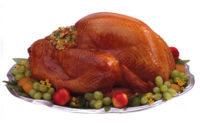State of the Industry: Turkey facing new economic realities






The odds are that crop production forecasts, especially those for corn, will get smaller in the near term, not larger. Feed is 70 percent of the cost of producing a turkey, so if production of crops such as corn and soybean shrink, meat and poultry production will grow slowly, if at all. The turkey industry will continue to work toward amending to these new economic realities.
Exports
Turkey demand has been excellent this year, especially for exports. Current estimates project 590 million pounds of turkey meat will be exported in 2011, which comprises about 10 percent of total turkey production. In 2010, 583 million pounds of turkey were exported. The top three export markets for U.S. turkey meat were Mexico (321 million pounds), Hong Kong (24.8 million pounds) and Canada (21 million pounds). Boneless dark meat (31.5%) is still the top turkey product being exported, which is important to the turkey industry’s economic health.
Renewable Fuels Policy
The U.S. government’s renewable fuels policy is still a top priority for the turkey industry. NTF and its members were successful in achieving significant grassroots victories this past year. The Senate voted to repeal the Volumetric Ethanol Excise Tax Credit and the tariff on imported ethanol, while the House on the same day voted to prohibit USDA from spending funds in the coming fiscal year to install ethanol “blender pumps” at gas stations, a key part of the ethanol industry’s plan for the future. Despite these victories, NTF and its members recognize that the battle to reform federal renewable fuels policy into something more sensible is far from over.
As for the Renewable Fuels Standard, the turkey industry would like a flexible policy put in place that creates a practical, automatic and meaningful safety net to protect against a poor corn harvest. The turkey industry understands and supports the need to develop domestic sources of energy, but an adequate feed supply is a crucial priority. Food and energy should never be forced by government mandates to compete with each other for key inputs.
GIPSA’s Proposed Marketing Rule
USDA’s Grain Inspection, Packers and Stockyards Administration (GIPSA) proposed poultry and livestock marketing rule, if implemented, will increase regulatory and legal uncertainty for all segments of the turkey industry. USDA is finalizing its economic assessment of the GIPSA rule, but there still hasn’t been confirmation from the agency that they will submit the study for public comment before finalizing the rule. Ultimately, the turkey industry would like Congress to include appropriate changes to the rule in the 2012 Farm Bill so that any new regulations would conform to Congress’ specific recommendations in the 2008 Farm Bill.
Free Trade Agreements
The turkey industry supports the pending U.S. Free Trade Agreements (FTA) with Korea, Colombia and Panama. Combined, the three FTAs represent nearly $2.5 billion in new agriculture exports and could generate up to 22,500 new U.S. jobs. For example, by USDA estimates the Korea FTA alone would reduce tariffs on frozen turkey cuts from the current 18 percent ultimately down to zero over the next seven years.
Food Safety
After recent recalls, NTF members convened a summit to discuss an aggressive, comprehensive response to enhance Salmonella controls in turkey products. The summit allowed turkey processors to work together to identify a range of strategies to reduce the incidence of Salmonella in turkey.
The turkey industry prides itself on producing safe, nutritious and delicious food for the American consumer. Because the industry places the highest priority on food safety, NTF and its members already have created numerous best management practices (BMPs) to ensure the production of the highest quality, safest product possible. They include Food Safety Best Practices for the Production of Turkeys, Best Management Practices for the Production of Ground Turkey and Best Management Practices for Immersion Chilling. The industry will continue to research emerging technologies to reduce naturally occurring pathogens in turkey products.
Upgrade It! with Turkey Campaign
NTF and Shape Up America!, the healthy weight campaign spearheaded by former U.S. Surgeon General C. Everett Koop, commissioned a new survey that finds many parents are not equipped to assess their children’s weight status and lack the information to improve the meals children eat outside the home.
In response to the survey findings, NTF stepped up its efforts to show parents how to improve their children’s weight status by adding new extensions to the Meal Upgrade Calculator. Besides showing consumers how to “upgrade” favorite breakfast, lunch and dinner menus, this interactive Web site now gives parents the means to assess the weight status of their children and reduce the calories and fat consumed in meals served at school and in restaurants.
The Meal Upgrade Calculator is a way for NTF to show consumers that turkey offers a positive and simple step they can take to “upgrade” the family diet. Along with new tools to improve family meals, the calculator features information to help parents recognize overweight in their children and a new Family Activity Calculator that allows parents to select a favorite family activity — from taking a walk to playing tag or jumping rope — and then calculates the number of minutes it will take to burn an extra 100 calories.
Shape Up America! estimates that by taking advantage of these meal and activity “upgrades,” families can save an average of 100 calories a day through improvements to family meals and another 100 calories through increased physical activity — 200 fewer calories a day. These savings are significant and show that small changes in meal preparation and increased physical activity can pay off in meaningful health improvements.
The extensions to the Meal Upgrade Calculator are available at MealUpgrade.com.
Looking for a reprint of this article?
From high-res PDFs to custom plaques, order your copy today!











